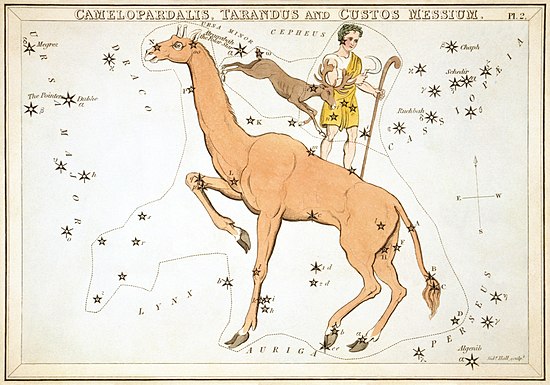Talk:Camelopardalis
| This is the talk page for discussing improvements to the Camelopardalis article. This is not a forum for general discussion of the article's subject. |
Article policies
|
| Find sources: Google (books · news · scholar · free images · WP refs) · FENS · JSTOR · TWL |
| This It is of interest to the following WikiProjects: | ||||||||||||||
| ||||||||||||||
"Invented"?[edit]
How does somebody invent a constellation? RickK 08:32, Jan 25, 2005 (UTC)
- "Created" is probably a better term. JYolkowski 22:02, 25 Jan 2005 (UTC)
- Or "newly designated" or "newly identified". ~~~~ 20:29, 14 Jun 2005 (UTC)
"Invented" seems better than "recorded" to me. The latter seems to imply (wrongly) that constellations are sitting there waiting to be discovered and named, like stars or planets! Gdr 19:17, 30 September 2005 (UTC)
- They are! If planets and stars sit awaiting being discovered, then the constellations are too. Rursus 19:55, 10 March 2007 (UTC)
- Bah, we don't invent stars or planets. Locations of stars are of course natural, but star patterns are purely human inventions. Especially those which are created only to fill empty space between the older and more conspicuous patterns. Unless you'er one of those who believe that a piece of artwork already exist somewhere and the job of an artist is to discover it. ;)--JyriL talk 23:45, 10 March 2007 (UTC)
Greek myth[edit]
The article says:
- However, as a desert, together with other features in the Zodiac sign of Gemini (i.e. the Milky Way, and the constellations Gemini, Orion, Auriga, and Canis Major), this may be the origin of the myth of the cattle of Geryon, which forms one of The Twelve Labours of Herakles.
I'm intrigued. What's the evidence for this claim? Gdr 19:17, 30 September 2005 (UTC)
Barfable visualisation[edit]
Those extremely ugly visualisations with lots of odd and sharp angles, besides being impossible to use in an amateur astronomer context (the only context when they are actually used), where does it come from? It's by all means certain that it is quite ahistoric, besides bugging me, and possibly also being laughable. Said: Rursus ☻ 20:33, 12 July 2008 (UTC)
Mythology[edit]
Partially incorrect:
- Camelopardalis has no mythology associated with its stars, as it is a modern constellation,
Hevelius associated it with the camel that Rebecka rode throught the desert to Isaac. Hevelius'es story is far fetched, since he assumes Camelopardalis is a camel, not a giraffe, but he is not that far from the desert/tent depiction that has been suggested being the Arabs depiction of the area of Camelopardalis. Said: Rursus (☻) 14:20, 28 November 2008 (UTC)
Johannes Hevelius did not give it the official name[edit]
The sentence "Johannes Hevelius gave it the official name [...] because he saw the constellation's many faint stars as the spots of a giraffe." should probably be removed. I find no evidence in his original works that Hevelius compared its faint stars with the spots of a giraffe. The cited source, Staal's The New Patterns in the Sky (p. 241), does not provide a reference to which of Hevelius's works this claim is to be found in. Like other stories on the constellations in this popular book (such as on Hydrus) its supposed mythology appears to be Staal's own invention. AstroLynx (talk) 10:58, 14 December 2012 (UTC)
- Correct. Johannes Hevelius did not give it the official name. Petrus Plancius added the constellation when he designed the globe published in 1613 by Pieter van der Keere [Engraver & Printer]. His name is translated from the Latin which reads Petrus Kaerius Flander Caelavit et Excudit. The likely reason you cannot find evidence is because most books from the 18th century and earlier are written in Latin. Even in the early 19th century, books were still being published in Latin. Americanplus (talk) 04:31, 3 November 2016 (UTC)
Voyager 1[edit]
Actually, Voyager 1 is not heading in the direction of the constellation Camelopardalis, as stated in the article, but in the direction of the constellation Ophiuchus. However, the star AC+793888, which is *now* in Camelopardalis, is flying in the direction of Cite error: There are <ref> tags on this page without content in them (see the help page). Ophiuchus, and Voyager 1 will pass this star at approx 1.6 light-year distance some 40,000 years from now. (source: https://voyager.jpl.nasa.gov/mission/interstellar-mission/) --Govert Schilling — Preceding unsigned comment added by 83.80.196.184 (talk • contribs) 14:20, 29 May 2018 (UTC)
Image from this article to appear as POTD soon[edit]
Hello! This is a note to let the editors of this article know that File:Sidney Hall - Urania's Mirror - Camelopardalis, Tarandus and Custos Messium.jpg will be appearing as picture of the day on 7 December 2018. You can view and edit the POTD blurb at Template:POTD/2018-12-07. If this article needs any attention or maintenance, it would be preferable if that could be done before its appearance on the Main Page. Thanks — Amakuru (talk) 16:06, 25 November 2018 (UTC)
This illustration was produced in around 1823 and comes from Urania's Mirror, a set of 32 astronomical star chart cards. Above the giraffe are the now-abandoned constellations of Tarandus and Custos Messium.Lithograph: Sidney Hall. Restoration: Adam Cuerden.
- Start-Class vital articles
- Wikipedia level-5 vital articles
- Wikipedia vital articles in Physical sciences
- Start-Class level-5 vital articles
- Wikipedia level-5 vital articles in Physical sciences
- Start-Class vital articles in Physical sciences
- Start-Class Astronomy articles
- Mid-importance Astronomy articles
- Start-Class Astronomy articles of Mid-importance
- Start-Class Constellations articles



